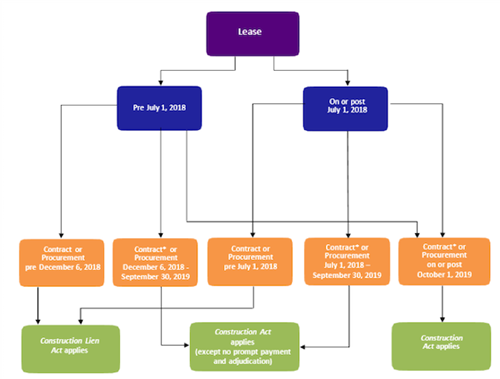Lost in transition
The correct application of the transition provisions in Ontario's new Construction Act has, in certain circumstances, stimulated robust debate and perhaps a little confusion. One such circumstance respects the construction of improvements on premises subject to leasehold interests. There is a certain silence in the Construction Act's transition provisions surrounding leaseholds that may leave some wondering whether the new act or the old Construction Lien Actapplies to their leasehold construction projects. In this article, we identify this silence and the correct interpretive way forward. We also provide a decision-tree to show which act applies to the construction of improvements subject to leasehold interests.
 The profound changes to Ontario's old Construction Lien Act took effect in two stages. The first stage respected a modernization of the old act. Among other things, monetary thresholds increased, the rules respecting the release of holdbacks changed, timelines for the expiry of liens were extended, and the old act was renamed the Construction Act. This first stage became effective on July 1, 2018. The second stage respected the ushering in of the revolutionary prompt payment and adjudication regimes. This second stage became effective on October 1, 2019.
The profound changes to Ontario's old Construction Lien Act took effect in two stages. The first stage respected a modernization of the old act. Among other things, monetary thresholds increased, the rules respecting the release of holdbacks changed, timelines for the expiry of liens were extended, and the old act was renamed the Construction Act. This first stage became effective on July 1, 2018. The second stage respected the ushering in of the revolutionary prompt payment and adjudication regimes. This second stage became effective on October 1, 2019.
Recognizing the dramatic change that each of these two stages would bring to Ontario's construction industry, the new act's framers provided for transition provisions to minimize disruption to existing relationships. The two-fold governing idea behind the Construction Act's transition provisions in section 87.3 is simple:
- each stage of the new act is to apply only to relationships that commence after the applicable effective date; and, correspondingly,
- the old act continues to apply to relationships already existing at the time of the applicable effective date.
In practice, however, the application of this simple idea has proved complicated—particularly in relation to leases. More than construction contracts and procurement processes, leases pose a particular challenge because many of them provide for relationships that extend decades into the future. Applying the simple idea behind the transition provisions to such lengthy leasehold relationships accordingly yields an undesirable result—that is, the old act would continue to apply decades from now.
To avoid such a result, the framers of the Construction Act made specific provision for leasehold interests entered into before July 1, 2018 in the new act's transition provisions for the first stage (i.e., for the modernization changes). Section 87.3(1) of the new act provides that the old act will still apply if any of the following three criteria are satisfied:
- a contract (i.e., a contract directly with an owner of the premises) for the improvement was entered into before July 1, 2018;
- a procurement process for the improvement was commenced by the owner of the premises before July 1, 2018; or
- in the case of a premises that is subject to a leasehold interest that was first entered into before July 1, 2018, a contract for the improvement was entered into or a procurement process for the improvement was commenced on or after July 1, 2018 and before December 6, 2018.
The act is, however, silent in respect of leases entered into on or after July 1, 2018. So how are we to understand application of these transition provisions to such leases?
Like any legislation, the Construction Act is to be interpreted according to its plain and ordinary language. As such, the new act's silence in relation to leases dated July 1, 2018 and thereafter means that such leases receive no special treatment under the Construction Act. Accordingly, where improvements are constructed on premises subject to leases dated July 1, 2018 and thereafter, the old act will continue to apply to them where the criteria in subparagraphs (a) and (b) of section 87.3(1) (noted above) are satisfied. The new act will otherwise apply to such leases.
There is also no specific reference, and accordingly no special treatment, for leases in respect of the Construction Act's transition provisions for the second stage of changes (i.e., for the prompt payment and adjudication regimes) in section 87.3(4). This section provides that the prompt payment and adjudication regimes will not apply where,
- a contract (i.e., a contract directly with an owner of the premises) was entered into before October 1, 2019;
- a procurement process for the improvement that is the subject of the contract was commenced by the owner of the premises before October 1, 2019; or
- a subcontract made under a contract referred to in subparagraphs (a) or (b) immediately above.
These second stage transition provisions apply equally to premises subject to leaseholds and those that are not.
The following decision-tree demonstrates which act applies to a lease given the date of the lease, the dates of applicable contracts and procurement processes, and whether the prompt payment and adjudication regimes apply. We hope you will find the decision-tree a helpful tool to cut through the silence surrounding leasehold interests and prevent you from getting lost in transition.

It is assumed that contracts marked with an asterisk (*) are not subject to a procurement process that pre-dates the dates noted in the cell. Where there is such a procurement process, the date of that procurement process instead determines which act applies.
This article was written by Jason J. Annibale and Jeremy Rankin of McMillan LLP. They can be reached at jason.annibale@mcmillan.ca and jeremy.rankin@mcmillan.ca.








